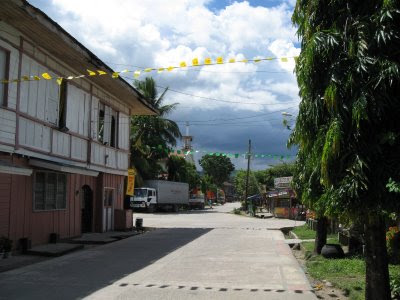By chance, I chance across a photo of Drimnagh, Dublin, taken in the 1940s. It was then a new suburb of Dublin and I spent the first three years of my life there, before we moved in 1946 to the northside of the city where I had been born. (The Northside/Southside distinction is very important for Dubliners!) The street where we lived is not in the photo but is to the right of the area shown. However, the newly-built church of Our Lady of Good Counsel, Mourne Road, is very clear, with the new parish school to its right. In Dublin people always refer to a Catholic church by its street name rather than by its patronal name.
On a Christmas weekday in 1945, or it could have been very early in January 1946, my mother, pregnant at the time, took me to Mass. I was a few months short of three. It seems I shouted 'Bah' at the Infant Jesus in the crib. The priest ordered my mother and myself out. It seems he was 'ably assisted' by an older woman who made sure my mother understood what the priest had said.
I'm sure the priest had got out of bed 'on the wrong side' that morning, as I sometimes do myself. My father went to see him some days later but the priest didn't apologise. It would have helped had he done so.
I have one memory of the incident, a 'photo' in my mind while walking home. As you can imagine, it was a shattering incident for my mother. My father went to see the priest but he never apologised. However, whenever my mother told this story she always mentioned that the same priest (not the priest in the inset above but a curate, as an assistant priest is known in Ireland), having moved to the parish where my mother had grown up, couldn't have been kinder to her younger sister Madge in her last illness. Auntie Madge died on 3 February 1950 at the age of 26. Hers was my first experience with the death of someone close to me. My mother brought me to the wake.
I was at home during Lent 1991 and Our Lady of Good Counsel parish asked for a Columban to preach at all the Masses one weekend in connection with a 24-hour fast by secondary school students to raise funds for Trócaire, the development agency of the Catholic Church in Ireland. Fr Michael Scully, the Columban Vice Superior in Ireland at the time, who knew nothing about my connection with Drimnagh, asked me if I could respond to the request.
I had the best opening line ever to a homily: 'I was thrown out of this church'. (In Dublin dialect that would be 'I was thrun ouhah this church'.) My mother died in 1970 and as I repeated my homily I felt a vicarious healing on her behalf. I also discovered that the parish was formally established eleven days before my birth. Now it's part of a cluster of three parishes working together as a unit
This incident has helped me more than once, though it's essentially a story rather than an experience for me. I have been very harsh with people on occasion in church. But whenever this has happened I've had the grace to ask the person later for forgiveness. And I'm usually very patient with small children making noise, though once or twice I've had to ask quietly if the parent or guardian could take care of a particular child.
One situation that does get to me here in the Philippines is children playing with coins on the floor of a church or chapel. However, I grin and bear it and it's a very long time since I've been in such a situation.
I found this photo on the parish website. Our Lady's Children's Hospital is in nearby Crumlin.. The words in Irish Gaelic mean 'Your two arms around them, O Christ'. A beautiful memorial.

















 S
S
























